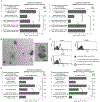Syngeneic red blood cell-induced extracellular vesicles suppress delayed-type hypersensitivity to self-antigens in mice
- PMID: 31365154
- PMCID: PMC6854290
- DOI: 10.1111/cea.13475
Syngeneic red blood cell-induced extracellular vesicles suppress delayed-type hypersensitivity to self-antigens in mice
Abstract
Background: At present, the role of autologous cells as antigen carriers inducing immune tolerance is appreciated. Accordingly, intravenous administration of haptenated syngeneic mouse red blood cells (sMRBC) leads to hapten-specific suppression of contact hypersensitivity (CHS) in mice, mediated by light chain-coated extracellular vesicles (EVs). Subsequent studies suggested that mice intravenously administered with sMRBC alone may also generate regulatory EVs, revealing the possible self-tolerogenic potential of autologous erythrocytes.
Objectives: The current study investigated the immune effects induced by mere intravenous administration of a high dose of sMRBC in mice.
Methods: The self-tolerogenic potential of EVs was determined in a newly developed mouse model of delayed-type hypersensitivity (DTH) to sMRBC. The effects of EV's action on DTH effector cells were evaluated cytometrically. The suppressive activity of EVs, after coating with anti-hapten antibody light chains, was assessed in hapten-induced CHS in wild-type or miRNA-150-/- mice.
Results: Intravenous administration of sMRBC led to the generation of CD9 + CD81+ EVs that suppressed sMRBC-induced DTH in a miRNA-150-dependent manner. Furthermore, the treatment of DTH effector cells with sMRBC-induced EVs decreased the activation of T cells but enhanced their apoptosis. Finally, EVs coated with antibody light chains inhibited hapten-induced CHS.
Conclusions and clinical relevance: The current study describes a newly discovered mechanism of self-tolerance induced by the intravenous delivery of a high dose of sMRBC that is mediated by EVs in a miRNA-150-dependent manner. This mechanism implies the concept of naturally occurring immune tolerance, presumably activated by overloading of the organism with altered self-antigens.
Keywords: delayed-type hypersensitivity to self-antigen; extracellular vesicles; immune suppression; miRNA-150; mouse model of delayed-type hypersensitivity to self-antigen; self-tolerance.
© 2019 John Wiley & Sons Ltd.
Conflict of interest statement
Conflict of Interest
The Authors declare that they have no relevant conflicts of interest.
Figures







Similar articles
-
Orally Administered Exosomes Suppress Mouse Delayed-Type Hypersensitivity by Delivering miRNA-150 to Antigen-Primed Macrophage APC Targeted by Exosome-Surface Anti-Peptide Antibody Light Chains.Int J Mol Sci. 2020 Aug 2;21(15):5540. doi: 10.3390/ijms21155540. Int J Mol Sci. 2020. PMID: 32748889 Free PMC article.
-
Intravenously administered contact allergens coupled to syngeneic erythrocytes induce in mice tolerance rather than effector immune response.Folia Med Cracov. 2019;59(1):61-73. Folia Med Cracov. 2019. PMID: 31180076
-
Antibody Light Chains Dictate the Specificity of Contact Hypersensitivity Effector Cell Suppression Mediated by Exosomes.Int J Mol Sci. 2018 Sep 7;19(9):2656. doi: 10.3390/ijms19092656. Int J Mol Sci. 2018. PMID: 30205452 Free PMC article.
-
Approaches to inducing antigen-specific immune tolerance in allergy and autoimmunity: Focus on antigen-presenting cells and extracellular vesicles.Scand J Immunol. 2020 Jun;91(6):e12881. doi: 10.1111/sji.12881. Epub 2020 May 7. Scand J Immunol. 2020. PMID: 32243636 Review.
-
T regulatory cells-derived extracellular vesicles and their contribution to the generation of immune tolerance.J Leukoc Biol. 2020 Sep;108(3):813-824. doi: 10.1002/JLB.3MR0420-533RR. Epub 2020 Jun 12. J Leukoc Biol. 2020. PMID: 32531824 Review.
Cited by
-
Increasing the Therapeutic Efficacy of Extracellular Vesicles From the Antigen-Specific Antibody and Light Chain Perspective.Front Cell Dev Biol. 2021 Nov 24;9:790722. doi: 10.3389/fcell.2021.790722. eCollection 2021. Front Cell Dev Biol. 2021. PMID: 34901032 Free PMC article.
-
The Role of Non-Immune Cell-Derived Extracellular Vesicles in Allergy.Front Immunol. 2021 Aug 19;12:702381. doi: 10.3389/fimmu.2021.702381. eCollection 2021. Front Immunol. 2021. PMID: 34489951 Free PMC article. Review.
-
Assessment of the Antigen-Binding Capacity and Separation of Extracellular Vesicles Coated with Antigen-Specific Antibody Light Chains.Methods Mol Biol. 2024;2821:225-236. doi: 10.1007/978-1-0716-3914-6_18. Methods Mol Biol. 2024. PMID: 38997493
-
Extracellular Vesicles-Oral Therapeutics of the Future.Int J Mol Sci. 2022 Jul 7;23(14):7554. doi: 10.3390/ijms23147554. Int J Mol Sci. 2022. PMID: 35886902 Free PMC article. Review.
-
Antibodies Enhance the Suppressive Activity of Extracellular Vesicles in Mouse Delayed-Type Hypersensitivity.Pharmaceuticals (Basel). 2021 Jul 27;14(8):734. doi: 10.3390/ph14080734. Pharmaceuticals (Basel). 2021. PMID: 34451831 Free PMC article.
References
-
- Filaci G, Fenoglio D, Indiveri F. CD8(+) T regulatory/suppressor cells and their relationships with autoreactivity and autoimmunity. Autoimmunity 2011;44:51–57. - PubMed
Publication types
MeSH terms
Substances
Grants and funding
LinkOut - more resources
Full Text Sources
Medical

